A Novel Illumination Compensation Technique for Multi-Spectral Imaging in NDVI Detection
Abstract
:1. Introduction
2. Materials
2.1. GreenSeeker Handheld Crop Sensor
2.2. Multi-Spectral Camera
2.3. Active Light Source
2.3.1. Integrated LED Array
- NIR is the reflection intensity of near-infrared light, w/m2.
- NIR1 is the incident intensity of near-infrared light, w/m2.
- R is the reflection intensity of red light, w/m2.
- R1 is the incident intensity of red light, w/m2.
2.3.2. Constant Current Power Supply
3. Methods and Results
3.1. Radiation Attenuation Test and Analysis
3.2. The Establishment of Radiation Attenuation Correction Model
3.3. Optical Radiation Attenuation Correction Model Verification
3.4. Grayscale Digital Number and Radiation Intensity
3.5. Test Verification and Analysis
4. Discussion
5. Conclusions
Author Contributions
Funding
Acknowledgments
Conflicts of Interest
References
- Huang, Y.B.; Chen, Z.X.; Yu, T.; Huang, X.Z.; Gu, X.F. Agricultural remote sensing big data: Management and applications. J. Integr. Agric. 2018, 17, 1915–1931. [Google Scholar] [CrossRef]
- Wu, C.Y.; Wang, L.; Niu, Z.; Gao, S.; Wu, M.Q. Nondestructive estimation of canopy chlorophyll content using Hyperion and Landsat/TM images. Int. J. Remote Sens. 2010, 31, 2159–2167. [Google Scholar] [CrossRef]
- Wang, P.; Lan, Y.B.; Luo, X.W.; Zhou, Z.Y.; Wang, Z.G.; Wang, Y.H. Integrated sensor system for monitoring rice growth conditions based on unmanned ground vehicle system. Int. J. Agric. Biol. Eng. 2014, 7, 75–81. [Google Scholar]
- Purba, J.; Sharma, R.K.; Jat, M.L.; Thind, H.S.; Gupta, R.K.; Chaudhary, O.P.; Chandna, P.; Khurana, H.S.; Kumar, A.; Uppal, H.S.; et al. Site-specific fertilizer nitrogen management in irrigated transplanted rice (Oryza sativa) using an optical sensor. Precis. Agric. 2015, 16, 455–475. [Google Scholar]
- Ni, J.; Yao, X.; Tian, Y.C.; Cao, W.C.; Zhu, Y. Design and experiments of portable apparatus for plant growth monitoring and diagnosis. Trans. Chin. Soc. Agric. Eng. 2013, 29, 150–156. [Google Scholar]
- Sankaran, S.; MishraR, A.; Ehsani, A. A review of advanced techniques for detecting plant diseases. Comput. Electron. Agric. 2010, 1, 1–13. [Google Scholar] [CrossRef]
- Houborg, R.; Anderson, M.; Dzughtry, C. Utility of an image-based canopy reflectance modeling tool for remote estimation of LAI and leaf chlorophyII content at the field scale. Remote Sens. Environ. 2009, 1, 259. [Google Scholar] [CrossRef]
- Gong, W.; Song, S.L.; Zhu, B.; Shi, S.; Li, F.Q.; Cheng, X.W. Multi-wavelength canopy LiDAR for remote sensing of vegetation: Design and system performance. Isprs J. Photogramm. Remote Sens. 2012, 69, 1–9. [Google Scholar]
- Cao, Q.; Miao, Y.X.; Feng, G.H.; Gao, X.W.; Li, F.; Liu, B.; Yue, S.C.; Cheng, S.S.; Ustin, S.L.; Khosla, R. Active canopy sensing of winter wheat nitrogen status: An evaluation of two sensor systems. Comput. Electr. Agric. 2015, 112, 54–67. [Google Scholar] [CrossRef]
- Yao, Y.K.; Miao, Y.X.; Huang, S.Y.; Gao, L.; Ma, X.B.; Zhao, G.M.; Jiang, R.F.; Chen, X.P.; Zhang, F.S.; Yu, K.; et al. Active canopy sensor-based precision N management strategy for rice. Agron. Sustain. Dev. 2012, 32, 925–933. [Google Scholar] [CrossRef] [Green Version]
- Erdle, K.; Mistele, B.; Schmidhalter, U. Comparison of active and passive spectral sensors in discriminating biomass parameters and nitrogen status in wheat cultivars. Field Crop. Res. 2011, 124, 74–84. [Google Scholar] [CrossRef]
- Barmeier, G.; Schmidhalter, U. High-Throughput Phenotyping of Wheat and Barley Plants Grown in Single or Few Rows in Small Plots Using Active and Passive Spectral Proximal Sensing. Sensors 2016, 16, 1860. [Google Scholar] [CrossRef] [PubMed]
- Kipp, S.; Mistele, B.; Schmidhalter, U. The performance of active spectral reflectance sensors as influenced by measuring distance, device temperature and light intensity. Comput. Electron. Agric. 2014, 100, 24–33. [Google Scholar] [CrossRef]
- Winterhalter, L.; Mistele, B.; Schmidhalter, U. Evaluation of active and passive sensor systems in the field to phenotype maize hybrids with high-throughput. Crop. Res. 2013, 154, 236–245. [Google Scholar] [CrossRef]
- Solari, F.; Shanahan, J.; Ferguson, R.; Schepers, J.; Gitelson, A. Active Sensor Reflectance Measurements of Corn Nitrogen Status and Yield Potential. Agron. J. 2008, 100, 571–579. [Google Scholar] [CrossRef]
- Ni, J.; Wang, T.T.; Yao, X.; Cao, W.X.; Zhu, Y. Design and Experiments of Multi-spectral Sensor for Rice and Wheat Growth Information. Trans. Chin. Soc. Agric. Mach. 2013, 44, 207–212. [Google Scholar]
- Mishra, A.; KarimiR, D.; Reza, E. Evaluation of an active optical sensor for detection of Huanglongbing (HLB) disease. Biosyst. Eng. 2011, 110, 302–309. [Google Scholar] [CrossRef]
- Ding, Y.Q.; Li, Y.; Tan, X.X.; Cao, W.X.; Zhu, Y. Control Stability of Active Light Source Spectra during Measuring Reflectance of Canopy. Trans. Chin. Soc. Agric. Mach. 2014, 45, 284–290. [Google Scholar]
- Ding, Y.Q.; Zhu, Y.; Li, Y.; Wang, Z.Q.; Tan, X.X.; Cao, W.X. A Method for Measuring Reflection Spectrum of Crop Canopy Based on Active Light Source. Trans. Chin. Soc. Agric. Mach. 2013, 44, 209–214. [Google Scholar]
- Li, X.H.; Li, M.Z.; Cui, D.; Miao, Y.X. Monitoring of rice plant growth in Northeast China using dual-wavebands crop growth analyzer. Trans. Csae 2011, 27, 206–210. [Google Scholar]
- Souza, H.B.; Baio, F.H.R.; Neves, D.C. Using passive and active multi-spectral sensors on the correlation with the phenological indices of cotton. Eng. Agric. 2017, 37, 782–789. [Google Scholar]
- Ali, A.M.; Abou-Amer, I.; Ibrahim, S.M. Using GreenSeeker active optical sensor for optimizing maize nitrogen fertilization in calcareous soils of Egypt. Arch. Agron. Soil Sci. 2018, 64, 1083–1093. [Google Scholar] [CrossRef]
- Barker, D.W.; Sawyer, J.E. Using Active Canopy Sensors to Quantify Corn Nitrogen Stress and Nitrogen Application Rate. Agron. J. 2010, 102, 964–971. [Google Scholar] [CrossRef] [Green Version]
- Eitel, J.U.H.; Keefe, R.F.; Long, D.S.; Davis, A.; Vierling, L. Active Ground Optical Remote Sensing for Improved Monitoring of Seedling Stress in Nurseries. Sensors 2010, 4, 2843–2850. [Google Scholar] [CrossRef] [PubMed]
- Sebasitian, C.; Fabio, R.; Michaela, D.; Marrco, D.; Mario, G. Evaluating Multi-spectral Images and Vegetation Indices for Precision Farming Applications from UAV Images. Remote Sens. 2015, 7, 4026–4047. [Google Scholar]
- Zhang, D.Y.; Zhou, X.G.; Zhang, J.; Lan, Y.B.; Xu, C.; Liang, D. Detection of rice sheath blight using an unmanned aerial system with high-resolution color and multi-spectral imaging. PLoS ONE 2018, 13, e0187470. [Google Scholar]
- Gianluca, F.; Edoardo, C.; Mirco, M.; Galvagno, M.; Sonnentag, O.; Humphreys, E.; Hufkens, K.; Ryu, Y.; Verfaillie, J.; di Cella, U.M.; et al. NDVI derived from near-infrared-enabled digital cameras: Applicability across different plant functional types. Agric. For. Meteorol. 2018, 249, 275–285. [Google Scholar]
- Zhang, N.; Qi, B.; Zhao, J.M.; Zhang, X.Y.; Wang, S.; Zhao, T.G.; Gai, J.Y. Prediction for Soybean Grain Yield Using Active Sensor Green Seeker. Acta Agron. Sin. 2014, 40, 657–666. [Google Scholar] [CrossRef]
- Zhao, C.J.; Liu, L.Y.; Zhou, H.C.; Wang, J.H.; Xue, X.Z. Development and application of a novel NDVI instrument. Opt. Tech. 2004, 3, 324–326. [Google Scholar]
- Brownson, J.R.S. Chapter 03—Laws of Light. Solar Energy Conversion Systems; Academic Press: Boston, MA, USA, 2014; pp. 41–66. [Google Scholar]
- Cao, S.; Danielson, B.; Clare, S.; Koenig, S.; Campos-Vargas, C.; Sanchez-Azofeifa, A. Radiometric calibration assessments for UAS-borne multi-spectral cameras: Laboratory and field protocols. Isprs J. Photogramm. Remote Sens. 2019, 149, 132–145. [Google Scholar] [CrossRef]

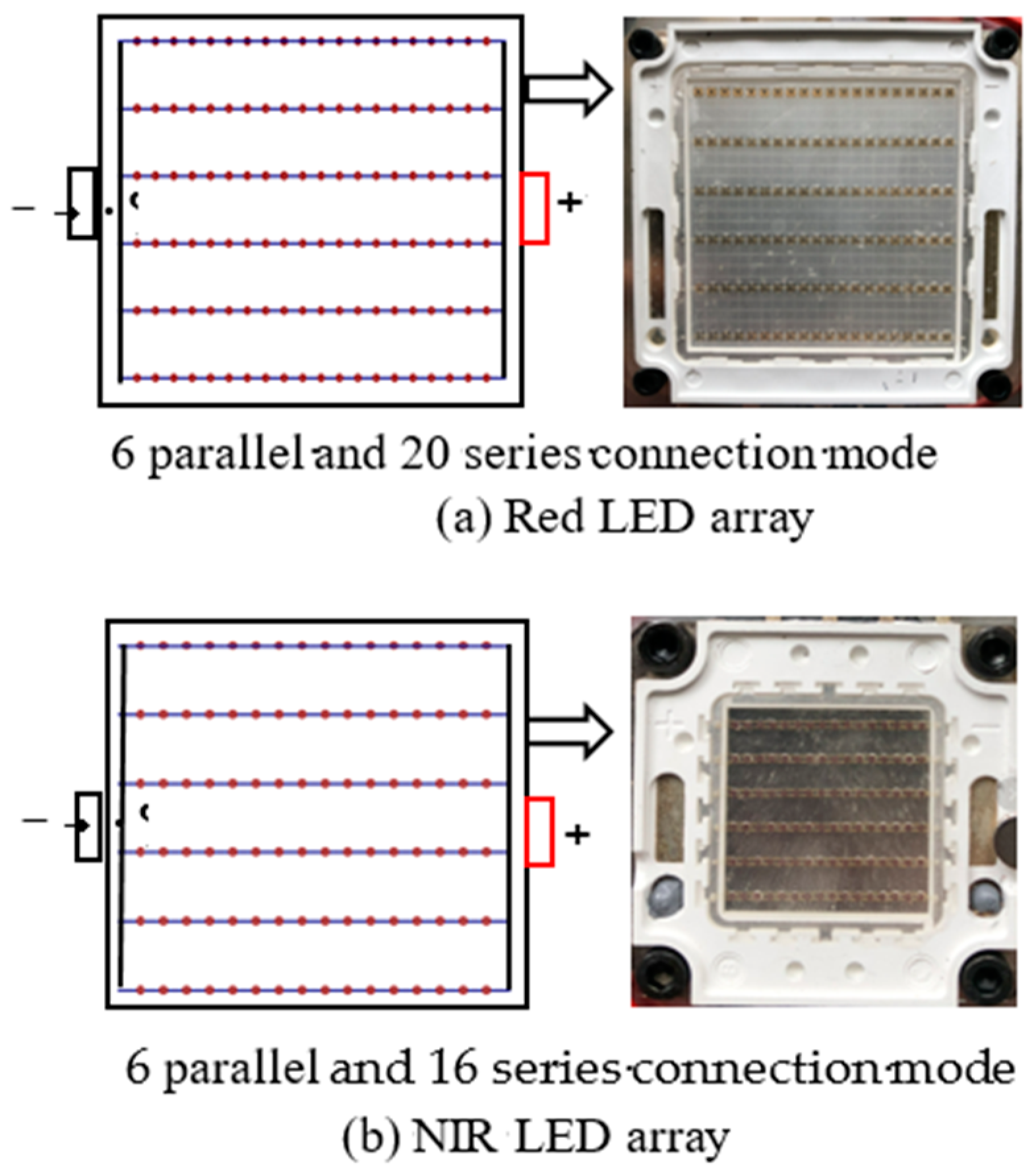
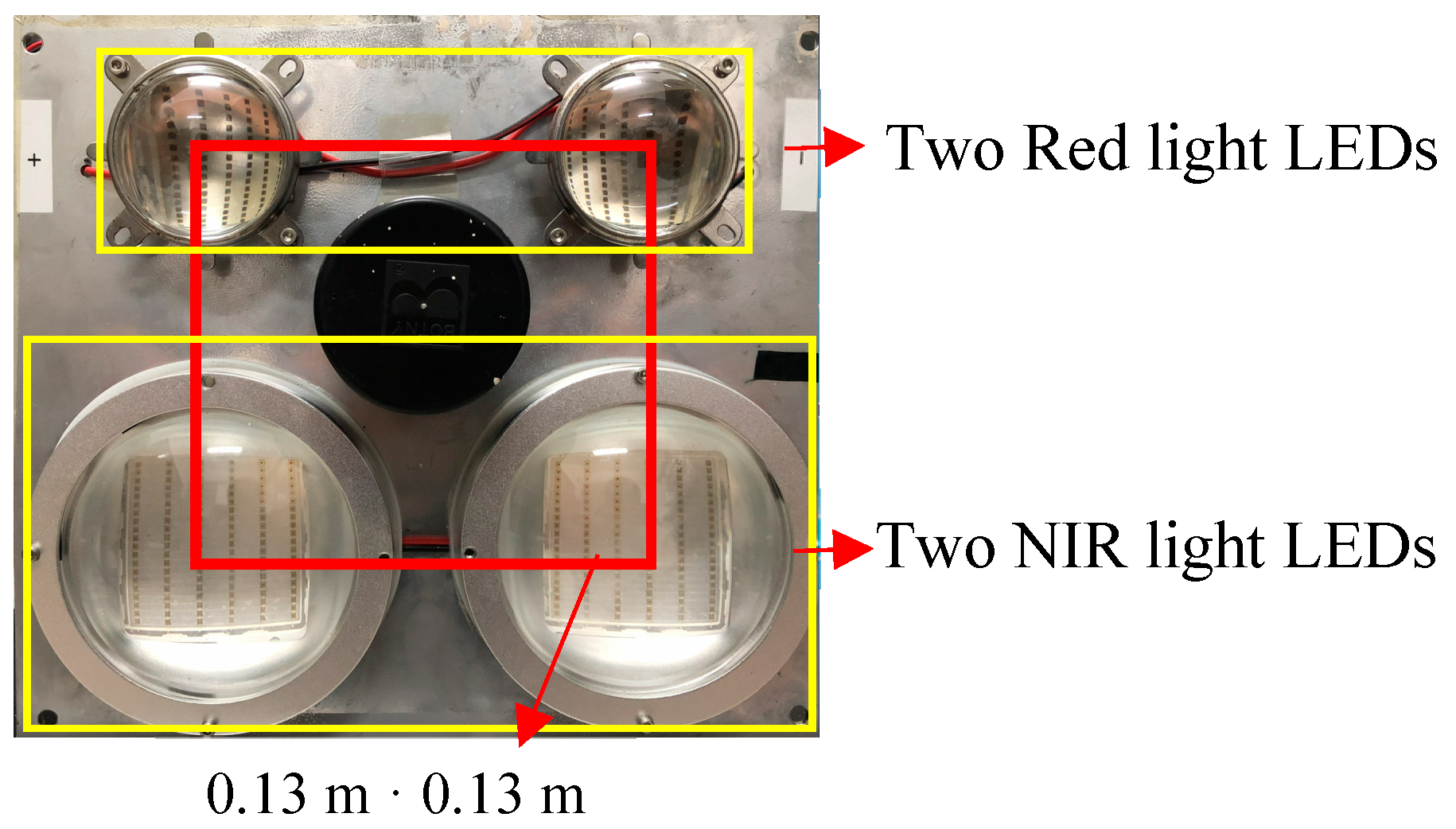
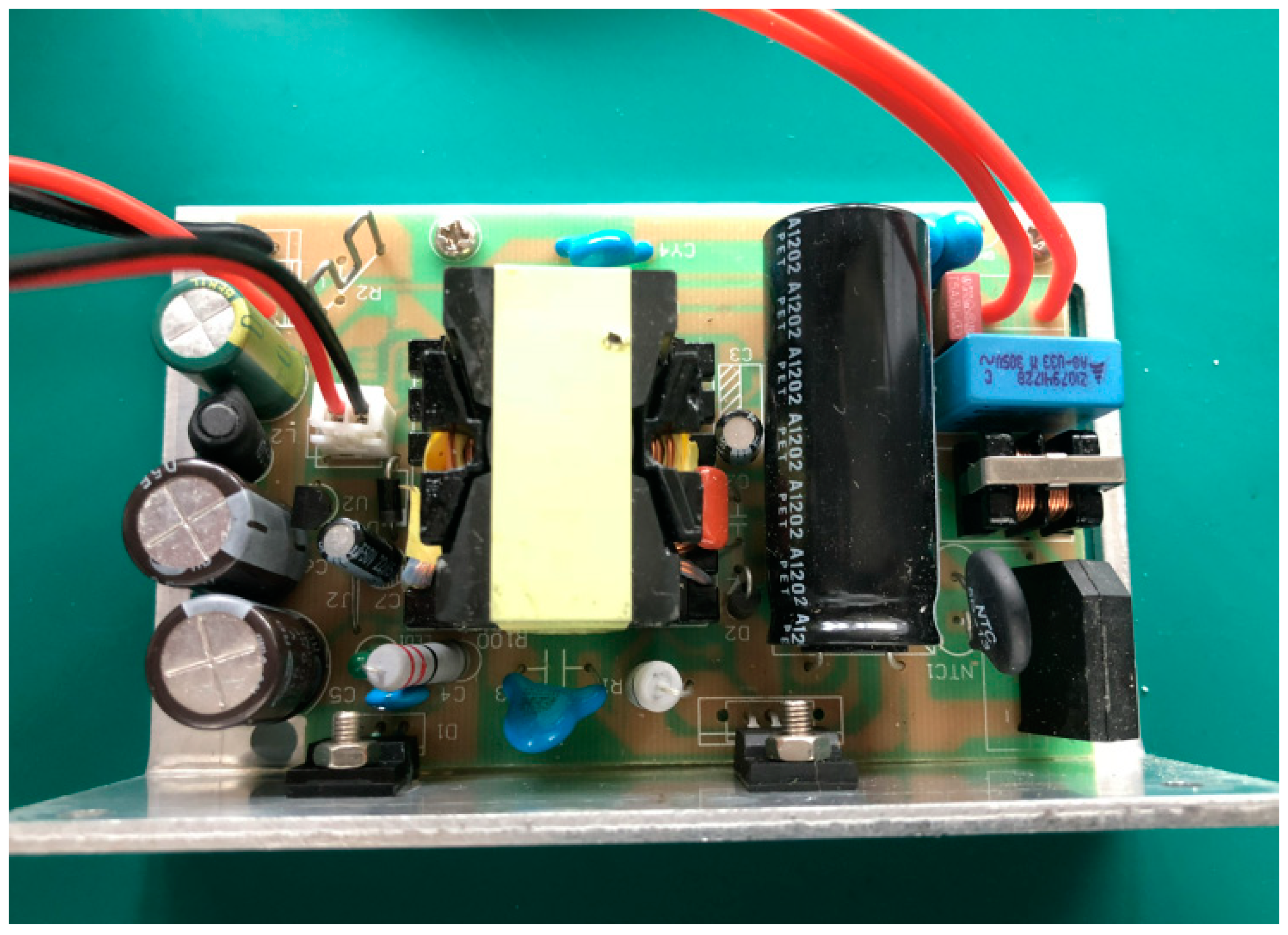
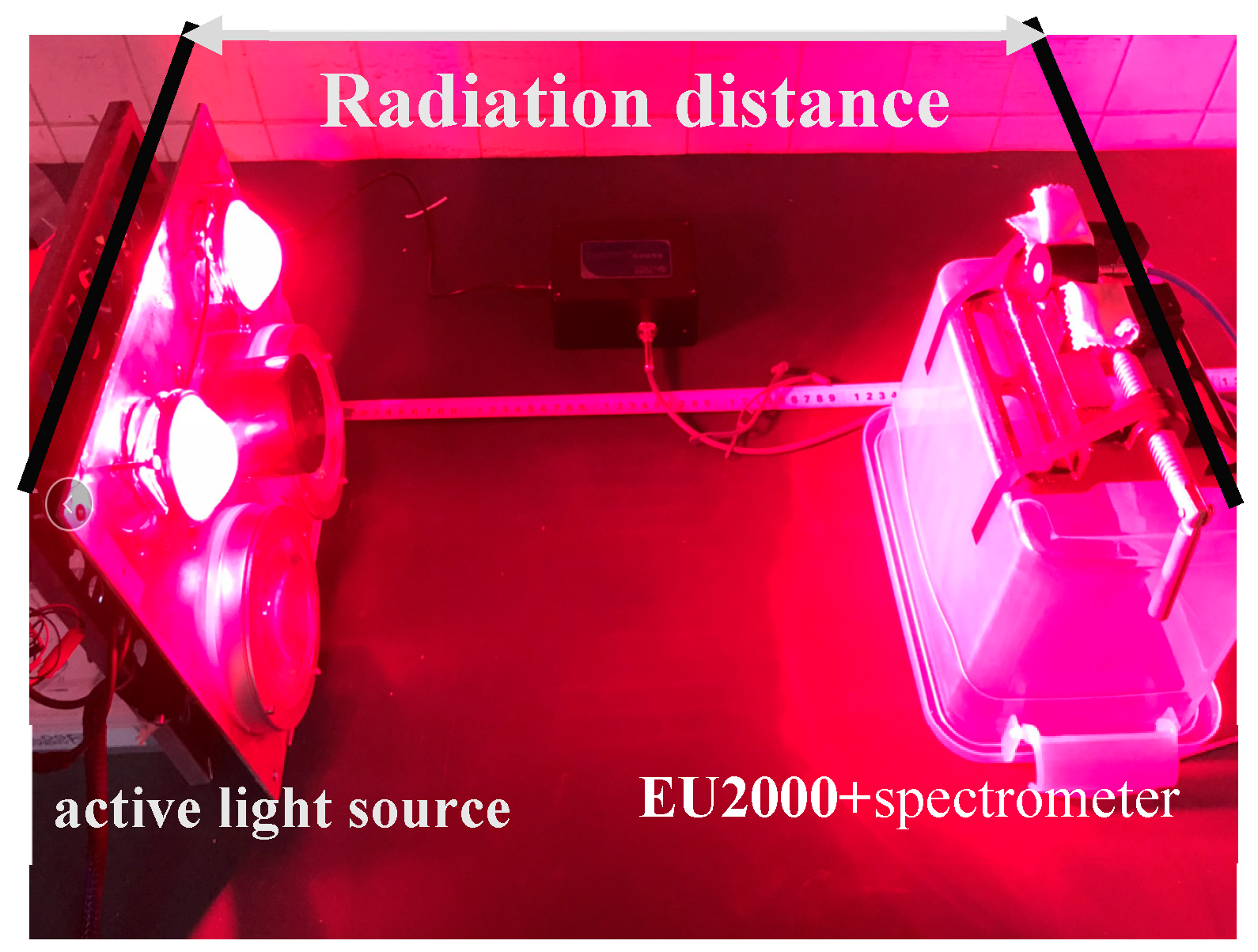



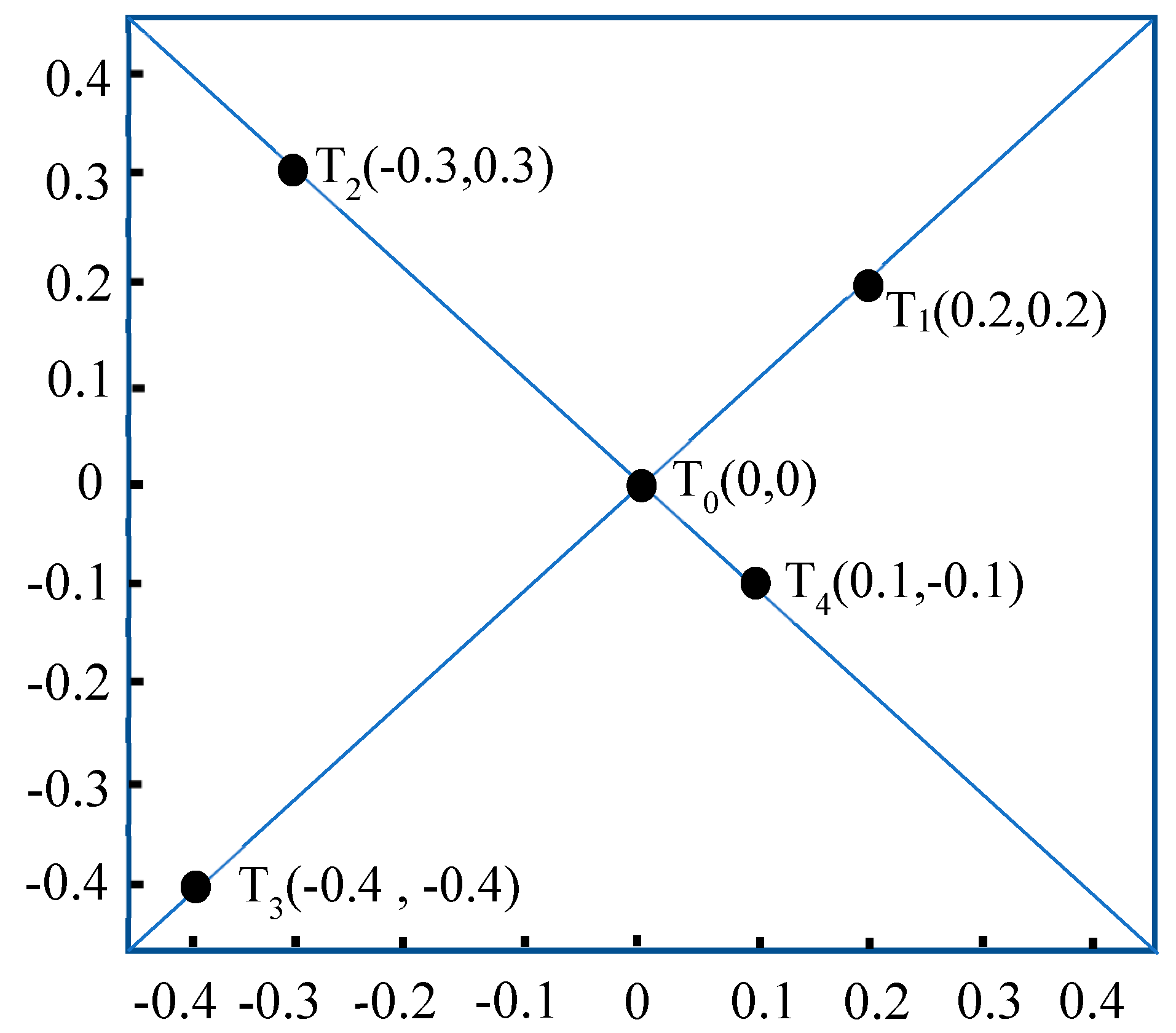
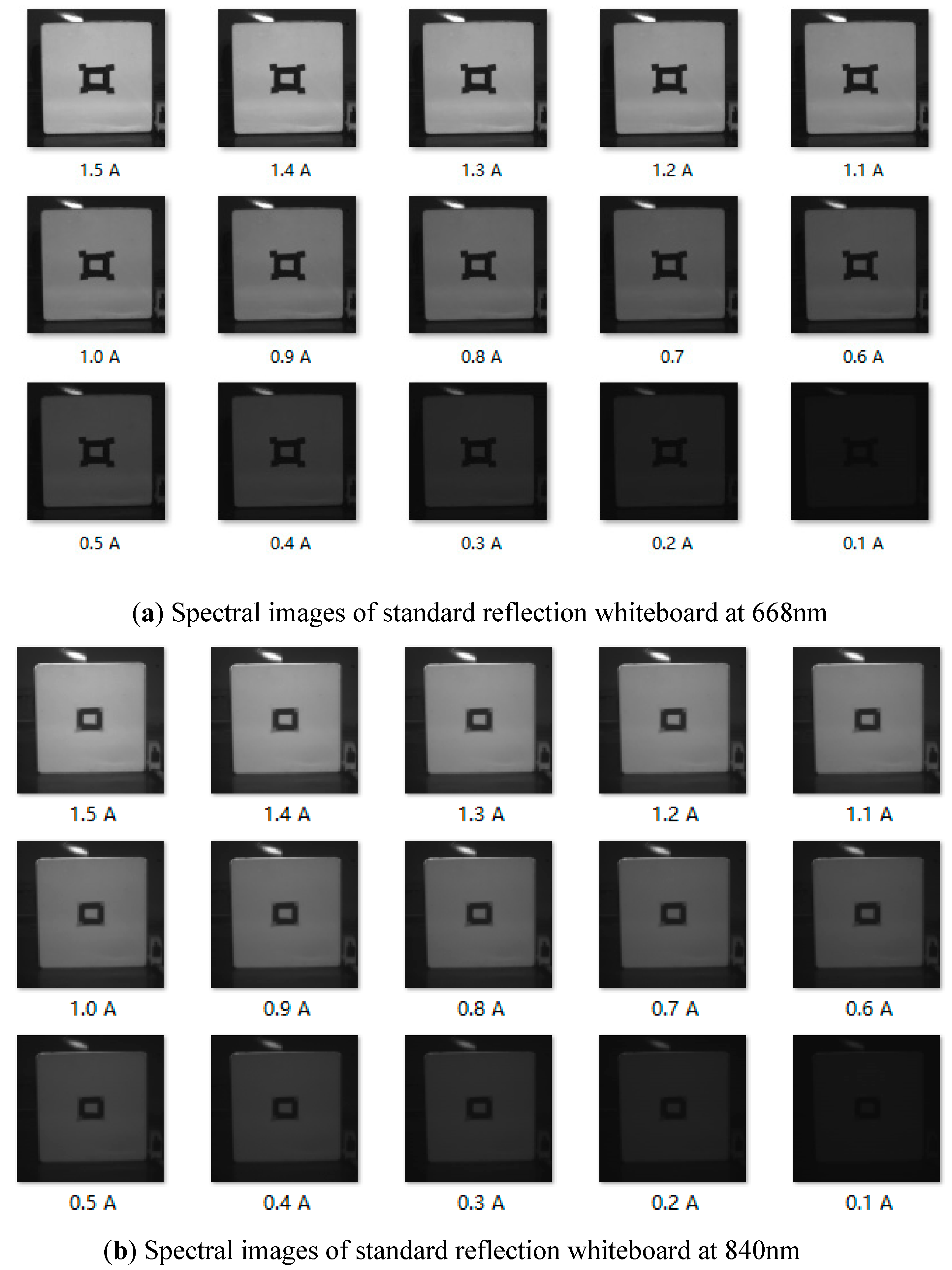
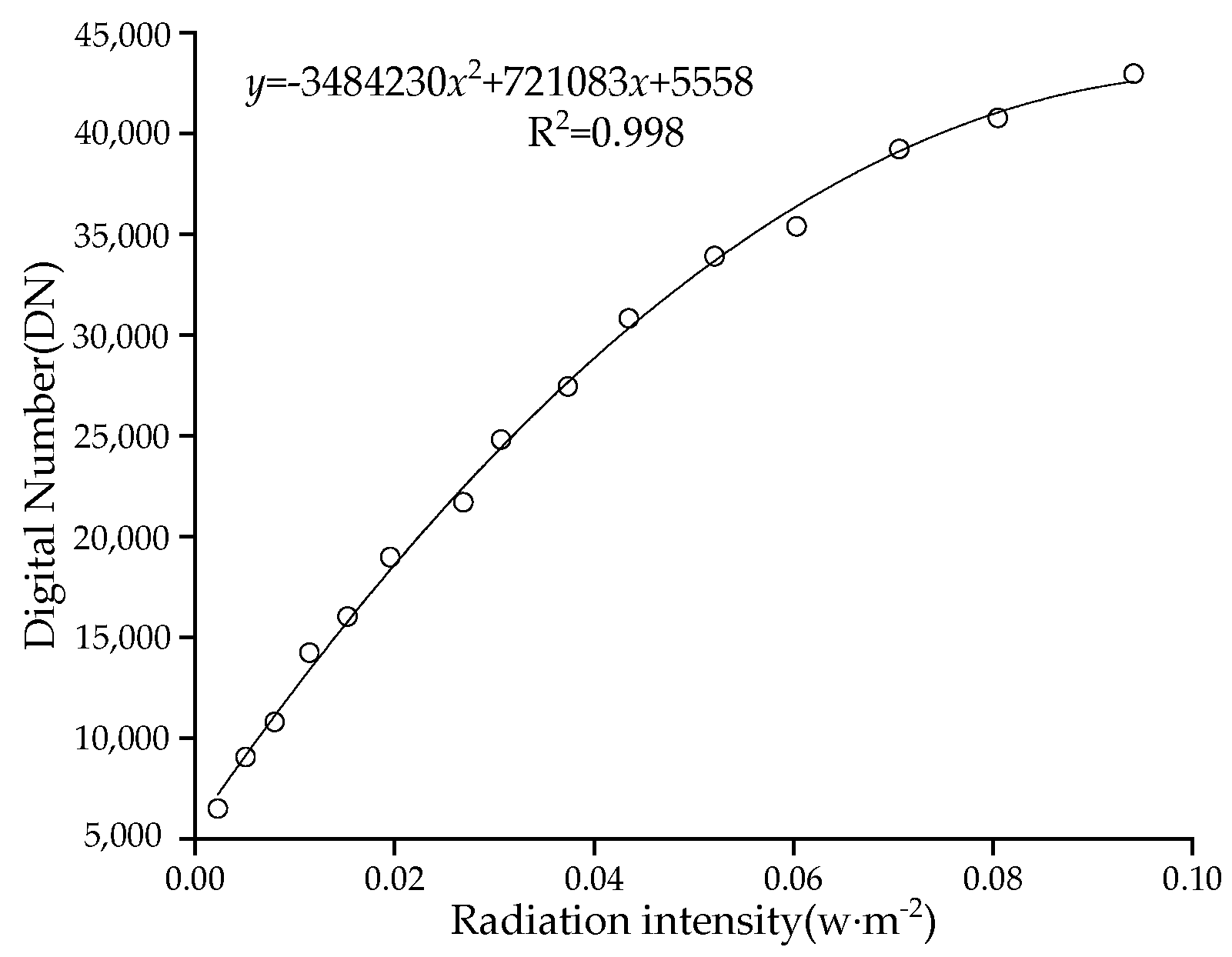
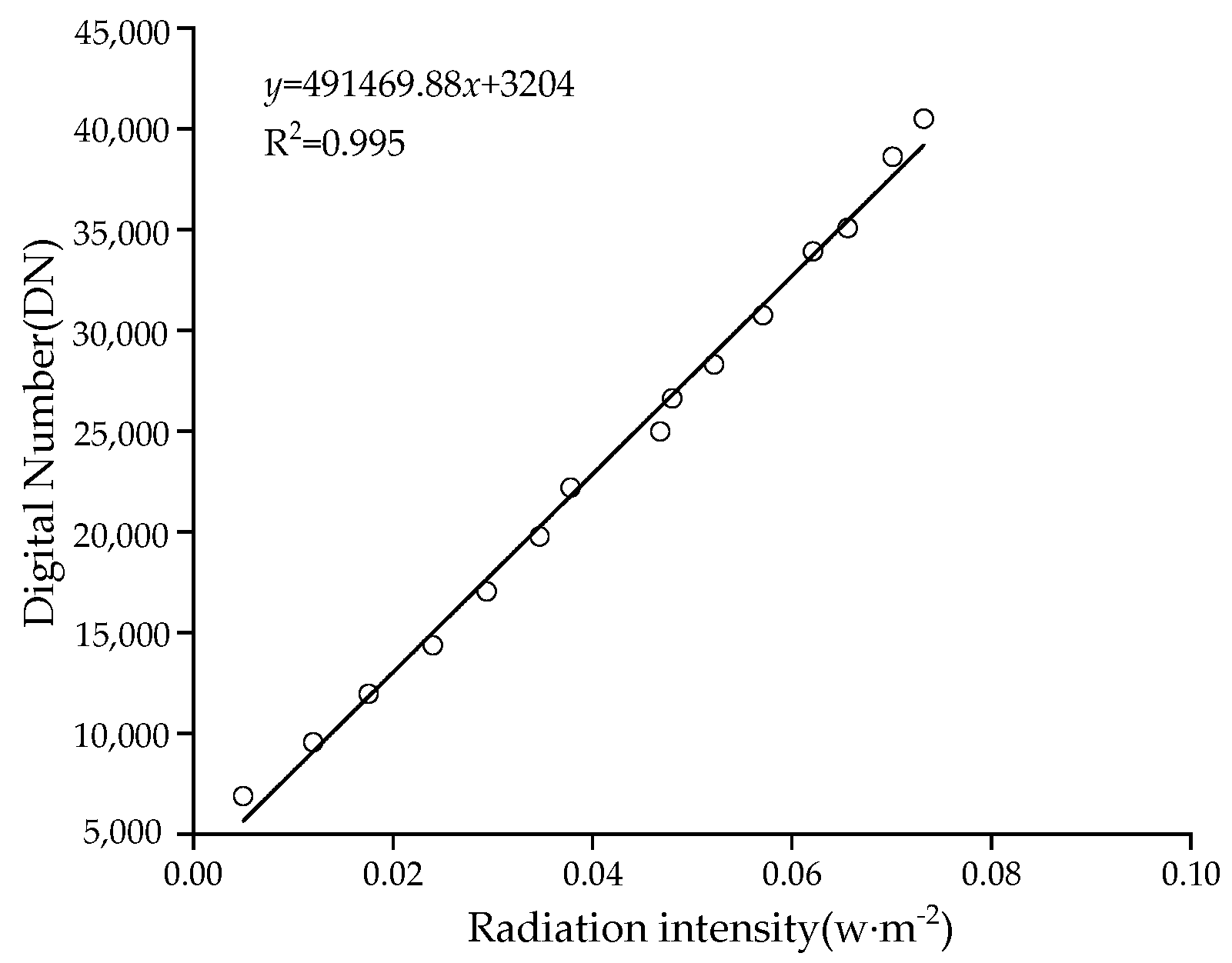
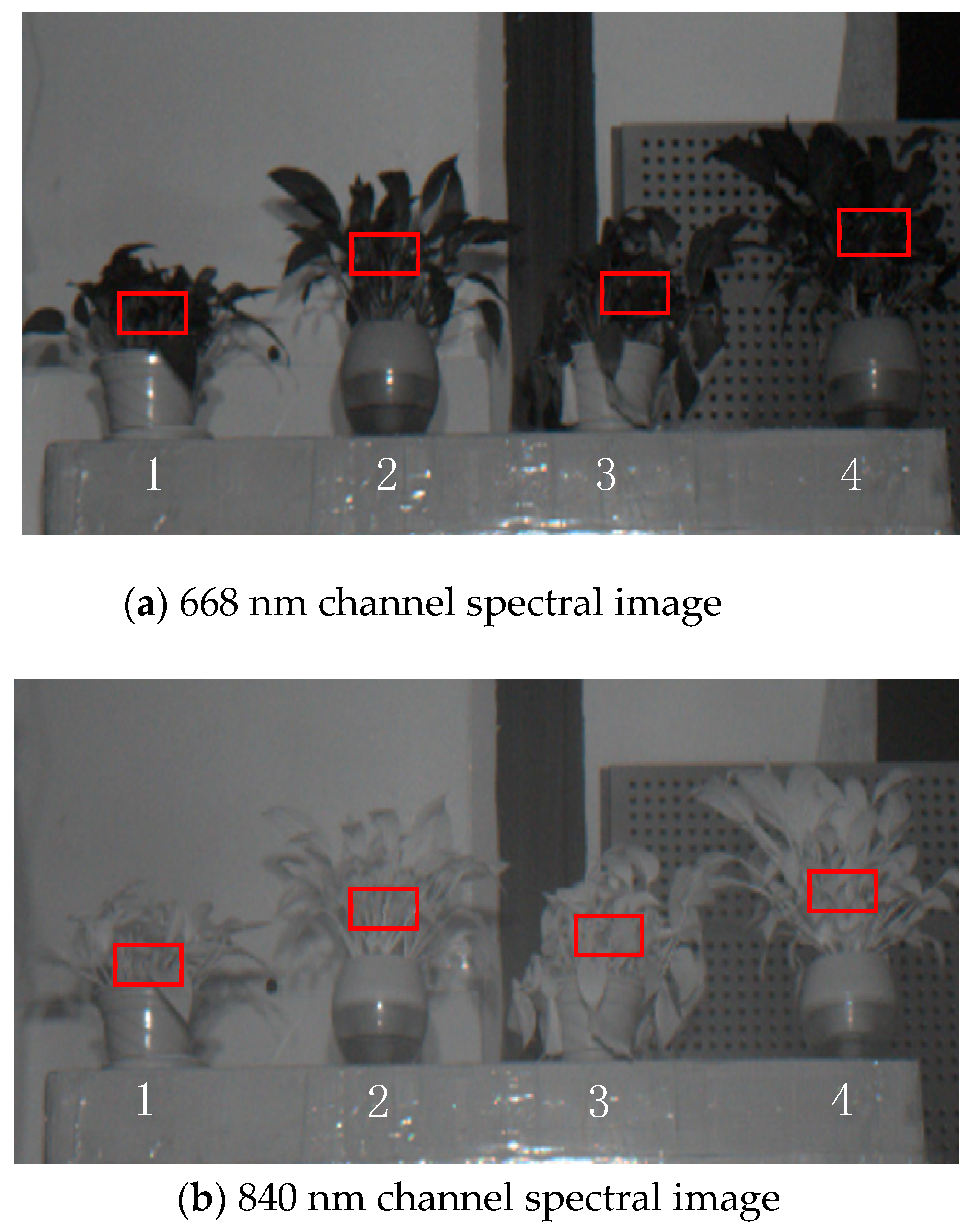
| Parameter | Unit | Value |
|---|---|---|
| Weight | g | 150 g |
| Dimensions | cm3 | 12.1 cm × 6.6 cm × 4.6 cm |
| Power | w | 5.0 V DC, 4 w |
| Spectral bands | blue, green, red, red edge, NIR | |
| Capture rate | s | 1 s (max) |
| Format | 16 bits TIFF, 12 bits DNG | |
| Field of view | ° | 47.2° |
| Band Number | Band | Center Wavelength (nm) | Band Width FWHM (nm) |
|---|---|---|---|
| 1 | Blue | 475 | 20 |
| 2 | Green | 560 | 20 |
| 3 | Red | 668 | 10 |
| 4 | Near IR | 840 | 40 |
| 5 | Red Edge | 717 | 10 |
| Parameter | Unit | Value |
|---|---|---|
| Input voltage | V | 100 ~ 240 |
| Output voltage | V | 26~36 |
| Output current | mA | 300 ~ 3200 |
| Parameter | Unit | Value |
|---|---|---|
| Range of band | nm | 400~1000 |
| accuracy | nm | ±0.4 |
| Linearity of photometry | % | ±0.5 |
| Integration time | ms | 3~60000 |
| Sensor | / | 2048 units CCD array |
| The optical fiber connector | / | SMA905 |
| Twice Test Distance/cm | Current/ A | RIR (668) | RIR (840) |
|---|---|---|---|
| 30/60 | 0.5 | 3.70 | 3.91 |
| 1 | 3.55 | 3.91 | |
| 1.5 | 3.85 | 3.95 | |
| 2 | 3.65 | 4.22 | |
| 2.5 | 3.54 | 4.59 | |
| 40/80 | 0.5 | 4.33 | 3.80 |
| 1 | 3.78 | 3.38 | |
| 1.5 | 3.98 | 3.62 | |
| 2 | 3.98 | 4.13 | |
| 2.5 | 3.81 | 3.87 | |
| 50/100 | 0.5 | 3.57 | 3.50 |
| 1 | 4.07 | 4.06 | |
| 1.5 | 4.11 | 4.36 | |
| 2 | 4.13 | 3.73 | |
| 2.5 | 4.22 | 3.76 |
| Coordinate Label | Pixel Coordinate | Radiation Intensity(w/m2) |
|---|---|---|
| 668[1] | (, ) | |
| 668[2] | (, ) | |
| 840[1] | (, ) | |
| 840[2] | (, ) |
| Coordinate (m) | Pixel Coordinates | P (668)/P (840), (w/m2) | M (668)/M (840), (w/m2) | Error 668 nm/840 nm, (w/m2) |
|---|---|---|---|---|
| T0(0,0) | 0, 0 | 0.0234/0.0208 | 0.0233/0.0207 | 0.0001/0.0001 |
| T1(0.2,0.2) | 138, 138 | 0.0230/0.0203 | 0.0228/0.0203 | 0.0001/0.0000 |
| T2(-0.3,0.3) | −223, 223 | 0.0226/0.0197 | 0.0226/0.0199 | 0.0002/0.0003 |
| T3(-0.4,0.4) | −283, 283 | 0.0219/0.0190 | 0.0216/0.0188 | 0.0003/0.0002 |
| T4(0.1,0.1) | 81, 81 | 0.0233/0.0206 | 0.0230/0.0204 | 0.0003/0.0002 |
| Number | IRI (668nm) | RRI (668nm) | IRI (840nm) | RRI (840nm) | NDVI(AS) | NDVI(GS) |
|---|---|---|---|---|---|---|
| 1 | 0.01154 | 0.00365 | 0.01026 | 0.00856 | 0.449 | 0.534 |
| 2 | 0.01154 | 0.00370 | 0.01027 | 0.00926 | 0.475 | 0.569 |
| 3 | 0.01154 | 0.00368 | 0.01027 | 0.00953 | 0.488 | 0.580 |
| 4 | 0.01152 | 0.00361 | 0.01026 | 0.01015 | 0.519 | 0.610 |
© 2019 by the authors. Licensee MDPI, Basel, Switzerland. This article is an open access article distributed under the terms and conditions of the Creative Commons Attribution (CC BY) license (http://creativecommons.org/licenses/by/4.0/).
Share and Cite
Jiang, R.; Wang, P.; Xu, Y.; Zhou, Z.; Luo, X.; Lan, Y. A Novel Illumination Compensation Technique for Multi-Spectral Imaging in NDVI Detection. Sensors 2019, 19, 1859. https://doi.org/10.3390/s19081859
Jiang R, Wang P, Xu Y, Zhou Z, Luo X, Lan Y. A Novel Illumination Compensation Technique for Multi-Spectral Imaging in NDVI Detection. Sensors. 2019; 19(8):1859. https://doi.org/10.3390/s19081859
Chicago/Turabian StyleJiang, Rui, Pei Wang, Yan Xu, Zhiyan Zhou, Xiwen Luo, and Yubin Lan. 2019. "A Novel Illumination Compensation Technique for Multi-Spectral Imaging in NDVI Detection" Sensors 19, no. 8: 1859. https://doi.org/10.3390/s19081859





